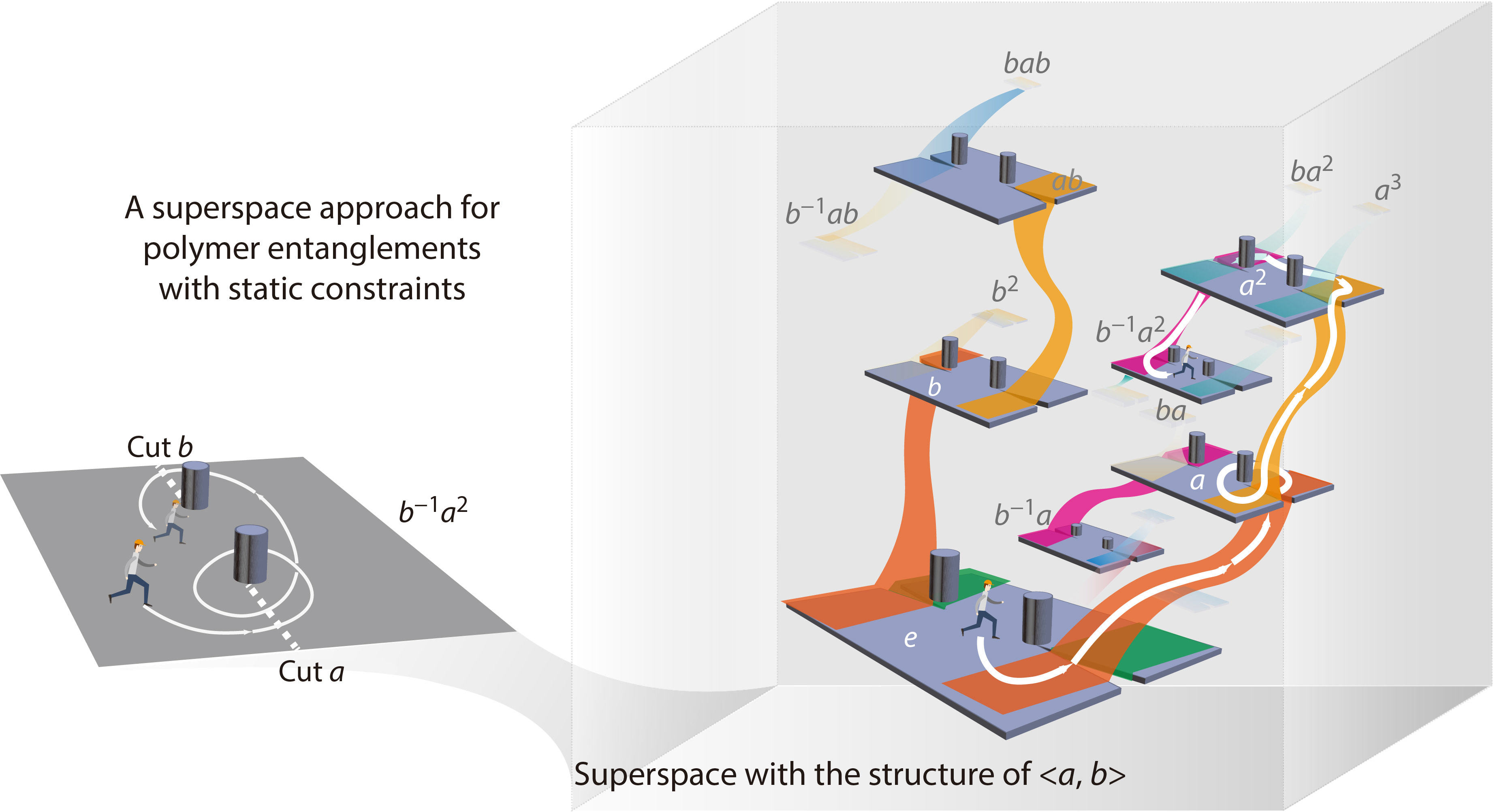INTRODUCTION
Polymer entanglement presents a great challenge in polymer physics. The development of a theoretical framework for the study of dynamic topological constraints is an extremely difficult and unsolved problem. On the other hand, great progresses have been made for the less difficult problem involving polymers entangled with static topological constraints. For the case of one polymer chain entangled with one static topological constraint, pioneering work has been carried out by a number of researchers.[1−8] In particular, using an analogue with the Schrödinger equation, Edwards[2,3] was able to derive the two-segment correlation function of a polymer chain winding around a pole with a given winding number on a 2D plane (Fig. 1a). It was speculated that this method could be extended to the cases of a polymer chain entangled with more than one poles or multiple static topological constraints. However, the problem of one polymer chain under multiple static topological constraints remains unsolved[7] because of the noncommutative character of multiple entanglements.[8]

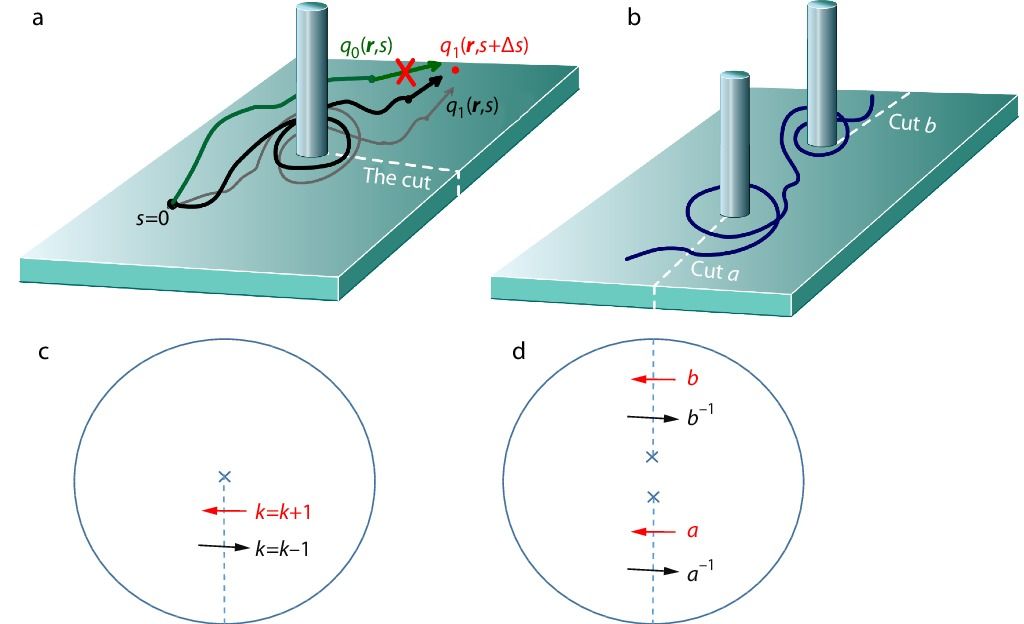
In the current study, we formulate the topological constraints of an entangled polymer chain using a superspace-based field theoretical approach, which combines the method from random walks on free groups[9] and Edwards' approach[2] for the one-pole case. In this theoretical formulation, the probability distribution of the chain segments is obtained by solving the Fokker-Planck or diffusion equation in a superspace consisting of a set of subspaces, and each subspace corresponds to a given entangling mode. This new approach is applied to the problem of a polymer chain subjected to n poles on a 2D plane. In this case, the superspace has a mathematical structure isomorphic to the n-generator free group.[10] For the case with one entangling pole, the superspace approach gives a simpler solution as compared with the previous approaches.[1−6] Furthermore, the force-extension curve of a polymer chain entangled with two poles is calculated, which contains a term originated from the topological constraints. The topological term of the force-extension curve is determined by a topological charge number which is an invariant for a given polymer entangling mode but it does not solely depend on the winding number. Physically, the topological charge reflects the number of independent perturbations along the entangled chain that is not Gaussian[11] or it measures how much the chain conformation deviates from Gaussian due to the topological constraints. To our best knowledge, this topological invariant is a new type of topological charge and is unique for Gaussian chains since there is no such correspondence in other fields [12] where the topological invariants normally depend on the winding number.
THEORETICAL METHOD
The theoretical approach starts with the partition function of an ideal polymer chain whose conformation is described by a space curve 

where the pre-factor in the exponential is 





The propagator 



For an ideal chain in the presence of topological poles, this correlation function not only depends on the arclength 







One method to explicitly incorporate the topological constraints of the poles into the probability distribution of the polymer conformations is to express the end-integrated propagator 





RESULTS AND DISCUSSION
From the perspective of group theory, the index g can be regarded as an element of the n-generator free group 
1. A superspace is defined as a set containing all the subspaces 
2. There are n basic operations or generators 

3. The n-generator free group 


Operationally, 




For the one-pole problem, the superspace is the complex logarithm Riemann surface (CLRS) (Fig. S1 in ESI). The 1-generator free group is simply isomorphic to the whole-number group or the one-winding-number representation 

For the two-pole problem, the superspace corresponds to the case with n=2, where 










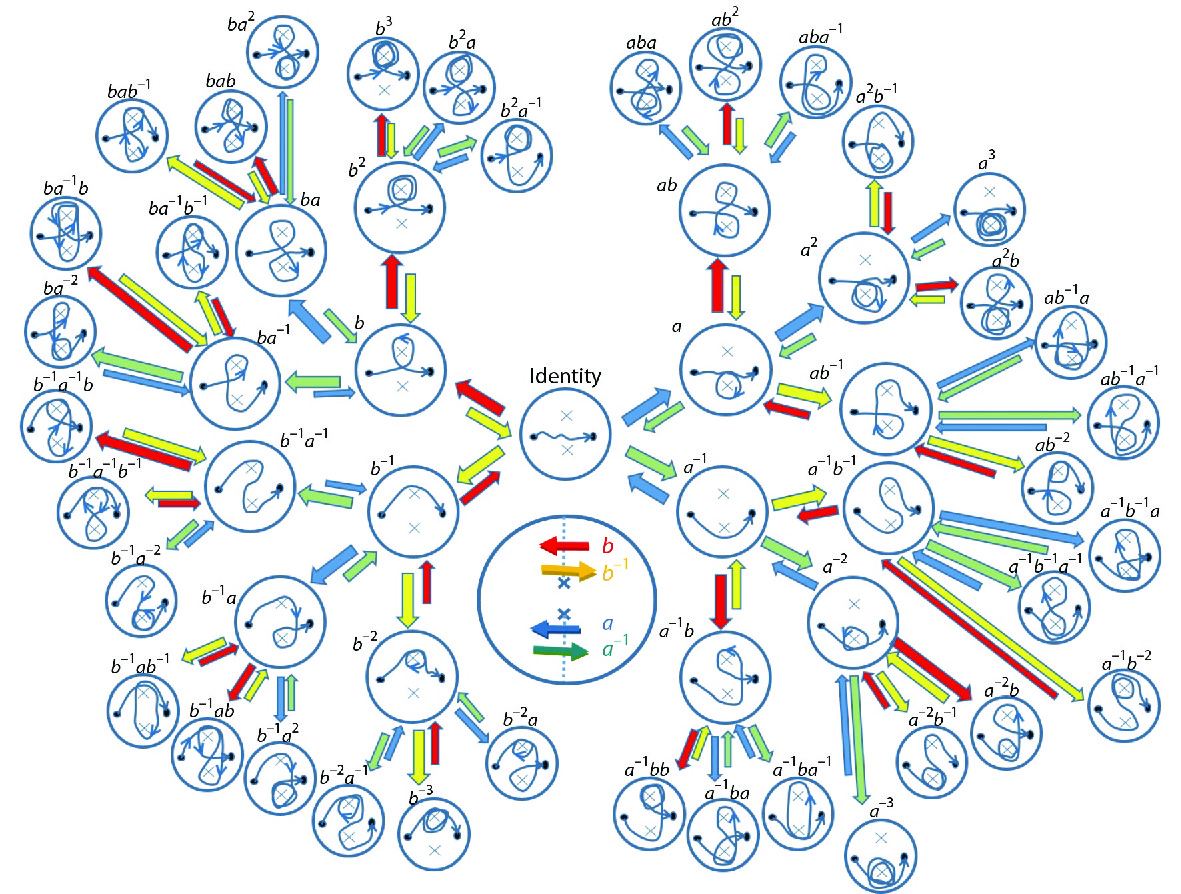
We emphasize that a polymer chain entangled with multiple poles can be seen as a random walk on a superspace 


In order to obtain basic statistical properties of a polymer chain subjected to static topological constraints, the force-extension curves of a polymer entangling with one pole or two poles in a 2D plane are computed. The procedure of calculating the force-extension curves is illustrated by the one-pole problem. In this case, we let the polymer wind the pole k-times with corresponding winding number k or −k and fix the two ends with a distance L between them. We then numerically or analytically solve the diffusion equation of 



Fig. 3 shows the force-extension curves of several entangling modes of a polymer chain in the presence of one pole or two poles, along with some of the chain density patterns. From the force-extension curves, it can be seen that when the extension L is small, the force does not exhibit a linear dependence on the extension. This non-linearity could be qualitatively explained by an entropy-loss argument (see Fig. S5b in ESI).





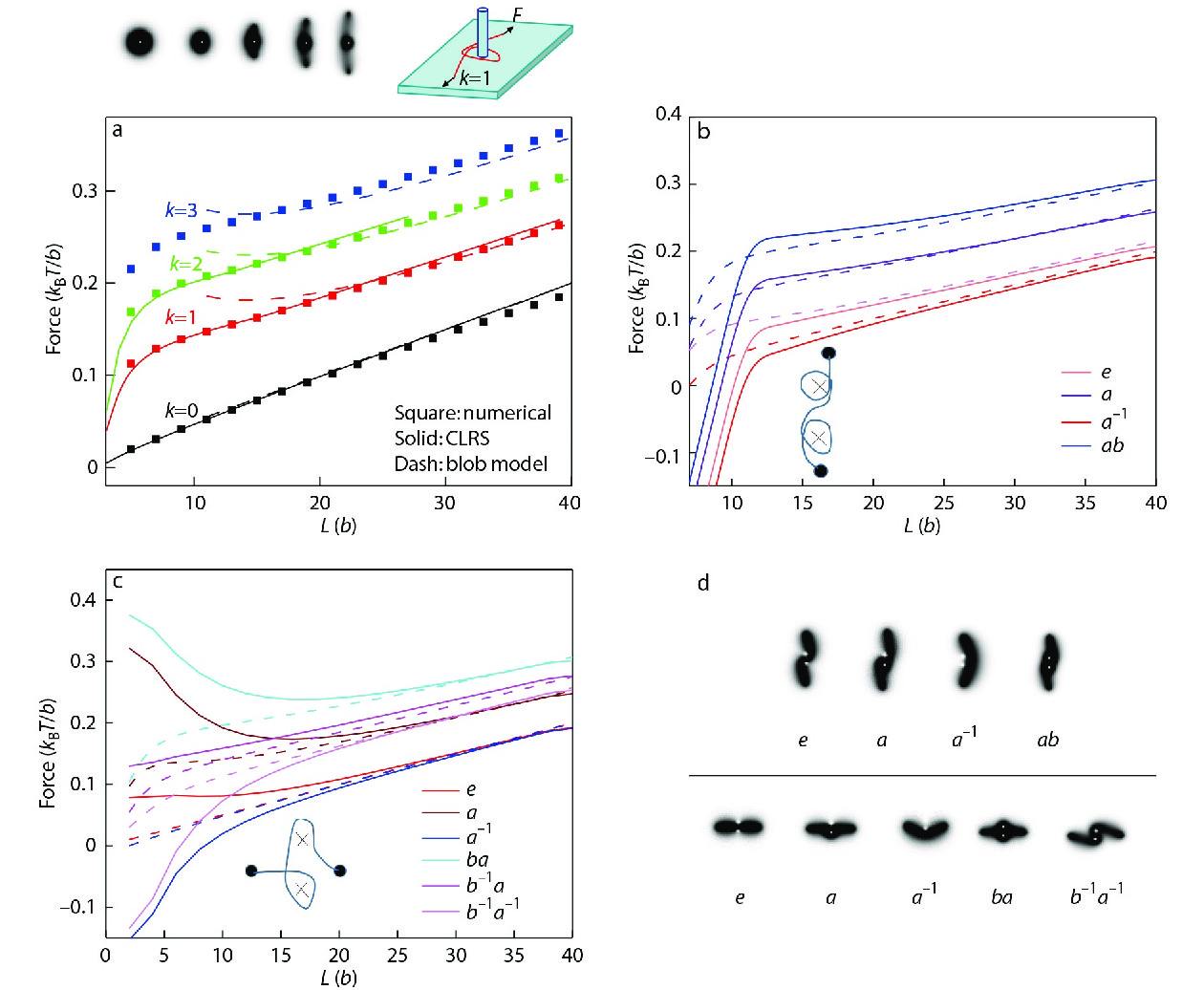
For large extensions, the force-extension curves exhibit a linear behavior with gaps between different entangling modes. These force gaps could be well explained by a blob model[16] with small perturbations (see ESI). Specifically the blob model predicts that the force-extension curves at large extension L could be approximated by,

where 

The first term in Eq. (4) is a linear function of the effective extension l, which describes an entropic spring with an extension l. Obviously this term depends on the specific entangling mode (including the winding number) as well as on the pole configuration. For example, in the one-pole case 

The distance d between the topological constraints is also important for the entangled behavior of polymers, as pointed out in previous literature.[17,18] In this work, we found the distance d mainly influences the force through the hidden extension l(L, d) as shown in Sect. IV-2 in ESI. Specifically, for 




The second term in Eq. (4), which is proportional to 



Although the topological charge emerges analytically in the one-pole case (Eq. S15 in ESI), the physics behind this topological invariant is obscured by the tedious mathematical derivations. We have discovered that the topological charge could be extracted from an entangled chain by perturbing the blob model. Intuitively, if one perturbs an unentangled Gaussian chain (Fig. 4a) with a displacement of the order of 















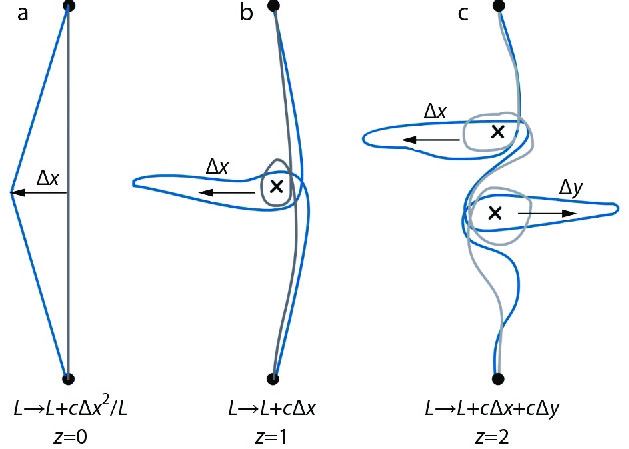
Although many important theoretical results have been obtained in the random walk on free groups[9] as well as in the problem of a ring polymer in an array of obstacles,[7,8] unfortunately, these results are difficult to be applied in the current work.
CONCLUSIONS
In summary, we have developed a superspace approach to studying the statistical mechanics of an ideal polymer chain entangled with n fixed poles. This approach gives a simpler solution to the one-pole problem compared with the solutions obtained by previous researchers.[1−6] Furthermore, the superspace approach enables us to compute the force-extension curves of a polymer chain entangling with one pole or two poles. The results reveal that generically the force-extension curves contain two terms at large extension. The first term is linear in the effective extension, reflecting the entropic contribution to the free energy. Whereas the second term is proportional to the inverse of the effective extension, reflecting a topological contribution to the free energy. The topological term is determined by the topological charge number of the entangling mode. The origin of the topological charge is revealed by perturbing the blob model of the chain. Each independent non-Gaussian perturbation gives a topological charge. This topological term characterizes the intrinsic nature of polymer entanglements with the static topological constraints.
Some theorems concerning 2-dimensional Brownian motionTrans
Am. Math. Soc. 1958 87 187Spitzer, F. Some theorems concerning 2-dimensional Brownian motionTrans. Am. Math. Soc. 1958, 87, 187.
The statistical mechanics of polymers with excluded volume
Proc. Phys. Soc. 1965 85 613Edwards, S. F. The statistical mechanics of polymers with excluded volume. Proc. Phys. Soc. 1965, 85, 613.
Statistical mechanics with topological constraints
Proc. Phys. Soc. 1967 91 513Edwards, S. F. Statistical mechanics with topological constraints. Proc. Phys. Soc. 1967, 91, 513.
Statistical mechanics of a simple entanglement
J. Chem. Phys. 1967 46 1475Prager, S.; Frisch, H.L. Statistical mechanics of a simple entanglement. J. Chem. Phys. 1967, 46, 1475.
Winding angle of a self-avoiding random walk
Phys. Rev. Lett. 1988 60 712Rudnick, J.; Hu, Y. Winding angle of a self-avoiding random walk. Phys. Rev. Lett. 1988, 60, 712.
Winding angle distribution for planar random walk, polymer ring entangled with an obstacle, and all that: Spitzer–Edwards–Prager–Frisch model revisited
J. Phys. A: Math. Gen. 2003 36 8955Grosberg, A.; Frisch, H. Winding angle distribution for planar random walk, polymer ring entangled with an obstacle, and all that: Spitzer–Edwards–Prager–Frisch model revisited. J. Phys. A: Math. Gen. 2003, 36, 8955.
Random walks on three-strand braids and on related hyperbolic groups
J. Phys. A: Math. Gen. 2003 36 43Nechaev, S.; Voituriez, R. Random walks on three-strand braids and on related hyperbolic groups. J. Phys. A: Math. Gen. 2003, 36, 43.
Finite range random walk on free groups and homogeneous trees
Ann. Probab. 1993 4 2087Lalley, S. P. Finite range random walk on free groups and homogeneous trees. Ann. Probab. 1993, 4, 2087.
Theory of inhomogeneous polymers: Fundamentals of the Gaussian random-walk model
J. Chem. Phys. 1975 62 999Helfand, E. J. Theory of inhomogeneous polymers: Fundamentals of the Gaussian random-walk model. J. Chem. Phys. 1975, 62, 999.
Nanoparticle Diffusion in Polymer Nanocomposites
Phys. Rev. Lett. 2014 112 108301Kalathi, J. T.; Yamamoto, U.; Schweizer, K. S.; Grest, G. S.; Kumar, S. K. Nanoparticle Diffusion in Polymer Nanocomposites. Phys. Rev. Lett. 2014, 112, 108301.
Hopping Diffusion of Nanoparticles in Polymer Matrices
Macromolecules 2015 48 847Cai, L. H.; Panyukov, S.; Rubinstein, M. Hopping Diffusion of Nanoparticles in Polymer Matrices. Macromolecules 2015, 48, 847.

